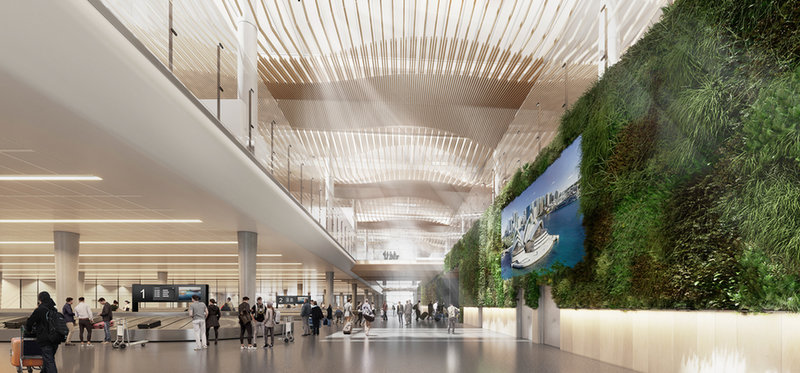baggage handling
Inside Vanderlande’s new baggage handling system for SWZ
Western Sydney Airport has contracted Vanderlande Industries Australia, a subsidiary of Toyota, to design, build and maintain its tote-based baggage handling system. Jasleen Mann finds out how the bespoke baggage system will work.
Image: copyright
Dutch airport logistics automation company Vanderlande will deliver a new baggage handling system to Western Sydney International (SWZ), to assist the airport in creating new jobs and providing passengers with access to regional and international connections 24/7. The project consists of several phases, with operational readiness and acceptance trials will take place in 2024.
SWZ, formally known as Western Sydney International Nancy-Bird Walton Airport, is a new development to the west of Sydney, which is designed to act as a supplement to the at-capacity Kingsford Smith Airport located to the south of the city. Construction of SWZ broke ground in 2018, after decades of debate over the project.
It is expected that when SWZ opens for its international, domestic, and air cargo services in 2026, it will be used by 10 million passengers each year; by the 2060s it could be one of Australia’s biggest gateways, used by 82 million passengers each year.
An SWZ spokesperson says: “As we’re designing Sydney’s new airport, we’re thinking forward and considering how tomorrow’s technology will come together with great design and customer service to create a seamless, stress-free experience.
“We’ll put ourselves in our passenger’s shoes to understand the pain points that cause frustration at most airports and consider if technology can offer a solution at SWZ.
“Standing around the baggage carousel not knowing when, or if, your bag will emerge on the conveyer belt is one of those anxious moments that many passengers know all too well.”
How the system works
With a new baggage handling system, the airport expects lost luggage will become a thing of the past by increasing the speed and reliability of the process. The system will be supported by an app that allows passengers to track the exact arrival time of their baggage.
Traditionally, baggage handling systems in Australia have relied heavily on manual handling operations, such as lateral belts, ground handlers, and other labour-intensive operations. The new baggage system aims to provide 100% bag tracking through a system that includes assisted loading and is compatible with advanced robotics.
The system Vanderlande is implementing at SWZ, the Adapto Bagstore, is based on shuttle technology controlled by a computer, which makes it possible for vehicles, dubbed shuttles, to store luggage and retrieve luggage.
A High-speed Tubtrax individual carrier system also allows in-tub screening. These solutions are integrated with VIBES, Vanderlande’s own controls platform. This software solution oversees the complete process.
Comparing SWZs baggage handling system to those at other airports... is like comparing a go-cart to a Tesla.
In addition, the system will include out-of-gauge baggage handling using Fleet Bag AV-technology, speed loaders for ULD loading, and a central make-up area. This will be connected to a sub-system, where couriers can drop off bags.
The system can ‘batch-build’, which means it is possible to automatically group luggage for delivery to the airside baggage makeup-up area and can then be loaded onto aircraft quicker.
“Simply put, there is nothing like this in Australia. Comparing SWZ's baggage handling system to those at other airports, which are based on technology that’s been around for half a century, is like comparing a go-cart to a Tesla,” adds the Western Sydney Airport spokesperson.
An efficient baggage handling system will benefit airlines by reducing delays at departure gates and lowering operating costs. The system could also easily expand in line with the airport’s capacity.
Reaping the benefits of redesign
IT services and consulting company DXC Technology is the technology partner of the airport, appointed in December 2021 to design the foundational structure to support 60 technology systems across the airport in cooperating.
SWZ is considered a unique greenfield opportunity as it does not need to retrofit aging technology and infrastructure. The building of the airport has included the integration of new technologies from the beginning of the process.
The airport will have an integrated international and domestic passenger terminal, to the airfield and air cargo hub as well as having airport security technology.

Vanderlande's baggage solution hopes to ease the process for passengers, and reduce congestion around baggage carousels
Technology is key to supporting the new airfield design. This will help avoid delays on the tarmac by reducing taxi times, delays that are costly for airlines. Planes will also get to the gates faster as a result of this.
The airport will also feature a modern CAT III-B runway, which will allow aircraft to continue to operate despite foggy conditions. SWZ will now have a 24/7 airport, a development which will be seen as bringing the airport in line with other major cities.
The spokesperson says: “Building SWZ provides a platform for growth in Sydney’s aviation capacity for decades to come, which is needed to ensure that Australia’s global city continues to compete on a global stage.
“When SWZ opens, passengers, airlines, and air cargo operators will have a choice about which Sydney airport they want to use.”
The opening of the airport will create a significant number of jobs and opportunities for local business, around 28,000 direct and indirect jobs by 2031.
Main image: Concept image of the new SWZ terminal. All images credit: Western Sydney Airport